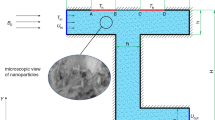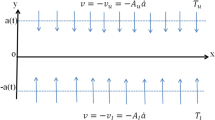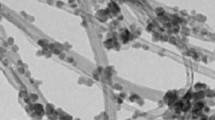Abstract
A two-dimensional (2D) numerical simulation is performed to simulate the laminar forced convection of a nanofluid in a ribbed channel with apart heating (cooling) sources using lattice Boltzmann method (LBM). The multi-walled carbon nanotubes–iron oxide nanoparticles/water hybrid nanofluid (MWCNT–Fe3O4/water hybrid nanofluid) is used in this simulation. The velocity field, temperature distribution and heat transfer rate are numerically analyzed with the streamlines and isotherm patterns employing of a house code. In addition, the effect of Reynolds number (Re = 25, 50, 75 and 100), nanoparticle solid volume fraction (ϕ = 0, 0.001, 0.003) and ratio of the blocks height (A = 0.2, 0.3, 0.4) are measured. The results are validated against the results reported in the literature, and a good agreement is reported. The obtained results show a maximum value of 16.49% increase in the average heat transfer coefficient for all the considered cases relative to the base fluid. Moreover, the local Nusselt number proves that the use of blocks on the channel walls can increase the amount of heat transfer. Finally, the average Nusselt number shows a linear dependence on the increasing ratio of blocks height for constant solid volume fraction. The results of this study apply to the industrial equipment heating and cooling applications.














Similar content being viewed by others
Abbreviations
- A :
-
h/H, ratio of the blocks’ height to the channel’s height
- B :
-
B = l/H, ratio of the distance between two consecutive blocks to the height of the channel
- C :
-
Lattice speed (m/s)
- c p :
-
Specific heat capacity at constant pressure (J/kg K)
- d :
-
Nanoparticle diameter (m)
- e :
-
Streaming speed for single particle
- f :
-
Density distribution function
- f eq :
-
Equilibrium density distribution function
- g :
-
Energy distribution function
- g eq :
-
Equilibrium energy distribution function
- H :
-
Channel height (m)
- K :
-
Thermal conductivity (W/(m K))
- k B :
-
Boltzmann constant (J/K)
- L :
-
Length of the channel (m)
- Nu :
-
Local Nusselt number
- Pr :
-
Prandtl number, ν/α
- Re :
-
Reynolds number, uin2H/ν
- T :
-
Time (s)
- T :
-
Temperature (K)
- T in :
-
Inlet temperature (K)
- T b :
-
Bulk temperature (K)
- U in :
-
U-component at the channel inlet (m s−1)
- u, v :
-
Velocity components (m s−1)
- u :
-
Velocity vector (m s−1)
- x, y :
-
Cartesian coordinates (m)
- ω :
-
Weight function
- α :
-
Thermal diffusivity (m−2 s−1)
- β :
-
Thermal expansion coefficient (K−1)
- µ :
-
Dynamic viscosity (kg m−1 s−1)
- δx :
-
Lattice spacing (m)
- δy :
-
Lattice spacing (m)
- δt :
-
Time step (s)
- ν :
-
Kinematic viscosity (m2 s−1)
- ρ :
-
Density of fluid (kg m−3)
- τ g :
-
Dimensionless single relaxation time for the heat transfer computation
- τ ν :
-
Dimensionless single relaxation time for the flow computation
- ϕ :
-
Solid volume fraction
- c:
-
Cold
- f:
-
Fluid
- h:
-
Hot
- i:
-
Move direction of single particle
- in:
-
Inlet
- nf:
-
Nanofluid
- p:
-
Particle
- out:
-
Outlet
- w:
-
Wall
- ′:
-
Dimensional quantity
References
Nazari M, Kayhani MH, Mohebbi R. Heat transfer enhancement in a channel partially filled with a porous block: lattice Boltzmann method. Int J Mod Phys C. 2013;24(09):1350060.
Nazari M, Mohebbi R, Kayhani MH. Power-law fluid flow and heat transfer in a channel with a built-in porous square cylinder: lattice Boltzmann simulation. J Nonnewton Fluid Mech. 2014;204:38–49.
Mohebbi R, Nazari M, Kayhani MH. Comparative study of forced convection of a power-law fluid in a channel with a built-in square cylinder. J Appl Mech Tech Phys. 2016;57(1):55–68.
Mohebbi R, Heidari H. Lattice Boltzmann simulation of fluid flow and heat transfer in a parallel-plate channel with transverse rectangular cavities. Int J Mod Phys C. 2017;28(03):1750042.
Mohebbi R, Rashidi MM. Numerical simulation of natural convection heat transfer of a nanofluid in an L-shaped enclosure with a heating obstacle. J Taiwan Inst Chem Eng. 2017;72:70–84.
Mohebbi R, Lakzayi H, Sidik NAC, Japar WMAA. Lattice Boltzmann method based study of the heat transfer augmentation associated with Cu/water nanofluid in a channel with surface mounted blocks. Int J Heat Mass Transf. 2018;117:425–35.
Mohebbi R, Rashidi MM, Izadi M, Sidik NAC, Xian HW. Forced convection of nanofluids in an extended surfaces channel using lattice Boltzmann method. Int J Heat Mass Transf. 2018;117:1291–303.
Mohebbi R, Izadi M, Chamkha AJ. Heat source location and natural convection in a C-shaped enclosure saturated by a nanofluid. Phys Fluids. 2017;29(12):122009.
Izadi M, Mohebbi R, Karimi D, Sheremet MA. Numerical simulation of natural convection heat transfer inside a⊥ shaped cavity filled by a MWCNT–Fe3O4/water hybrid nanofluids using LBM. Chem Eng Process Process Intensif. 2018;125:56–66.
Ma Y, Mohebbi R, Rashidi MM, Yang Z. Study of nanofluid forced convection heat transfer in a bent channel by means of lattice Boltzmann method. Phys Fluids. 2018;30(3):32001.
Esfahani JA, Akbarzadeh M, Rashidi S, Rosen MA, Ellahi R. Influences of wavy wall and nanoparticles on entropy generation over heat exchanger plat. Int J Heat Mass Transf. 2017;109:1162–71.
Shirvan KM, Mamourian M, Mirzakhanlari S, Ellahi R. Numerical investigation of heat exchanger effectiveness in a double pipe heat exchanger filled with nanofluid: a sensitivity analysis by response surface methodology. Powder Technol. 2017;313:99–111.
Ellahi R, Tariq MH, Hassan M, Vafai K. On boundary layer nano-ferroliquid flow under the influence of low oscillating stretchable rotating disk. J Mol Liq. 2017;229:339–45.
Shirvan KM, Ellahi R, Mamourian M, Moghiman M. Effects of wavy surface characteristics on natural convection heat transfer in a cosine corrugated square cavity filled with nanofluid. Int J Heat Mass Transf. 2017;107:1110–8.
Ijaz N, Zeeshan A, Bhatti MM, Ellahi R. Analytical study on liquid-solid particles interaction in the presence of heat and mass transfer through a wavy channel. J Mol Liq. 2018;250:80–7.
Zeeshan A, Shehzad N, Ellahi R. Analysis of activation energy in Couette–Poiseuille flow of nanofluid in the presence of chemical reaction and convective boundary conditions. Results Phys. 2017;8:502.
Rashidi S, Akar S, Bovand M, Ellahi R. Volume of fluid model to simulate the nanofluid flow and entropy generation in a single slope solar still. Renew Energy. 2018;115:400–10.
Mehryan SA, Ghalambaz M, Izadi M. Conjugate natural convection of nanofluids inside an enclosure filled by three layers of solid, porous medium and free nanofluid using Buongiorno’s and local thermal non-equilibrium models. J Therm Anal Calorim. 2018. https://doi.org/10.1007/s10973-018-7380-y.
Izadi M, Behzadmehr A, Shahmardan MM. Effects of inclination angle on mixed convection heat transfer of a nanofluid in a square cavity. Int J Comput Methods Eng Sci Mech. 2015;16(1):11–21.
Izadi M, Mehryan SA, Sheremet MA. Natural convection of CuO–water micropolar nanofluids inside a porous enclosure using local thermal non-equilibrium condition. J Taiwan Inst Chem Eng. 2018;88:89–103.
Izadi M, Hoghoughi G, Mohebbi R, Sheremet M. Nanoparticle migration and natural convection heat transfer of Cu–water nanofluid inside a porous undulant-wall enclosure using LTNE and two-phase model. J Mol Liquids. 2018;261:357–72.
Chamkha A, Ismael M, Kasaeipoor A, Armaghani T. Entropy generation and natural convection of CuO–water nanofluid in C-shaped cavity under magnetic field. Entropy. 2016;18(2):50.
Hoghoughi G, Izadi M, Oztop HF, Abu-Hamdeh N. Effect of geometrical parameters on natural convection in a porous undulant-wall enclosure saturated by a nanofluid using Buongiorno’s model. J Mol Liq. 2018;255:148–59.
Izadi M, Behzadmehr A, Jalali-Vahida D. Numerical study of developing laminar forced convection of a nanofluid in an annulus. Int J Therm Sci. 2009;48(11):2119–29.
Mehryan SA, Izadi M, Sheremet MA. Analysis of conjugate natural convection within a porous square enclosure occupied with micropolar nanofluid using local thermal non-equilibrium model. J Mol Liq. 2018;250:353–68.
Zaraki A, Ghalambaz M, Chamkha AJ, Ghalambaz M, de Rossi D. Theoretical analysis of natural convection boundary layer heat and mass transfer of nanofluids: effects of size, shape and type of nanoparticles, type of base fluid and working temperature. Adv Powder Technol. 2015;26(3):935–46.
Zargartalebi H, Ghalambaz M, Noghrehabadi A, Chamkha A. Stagnation-point heat transfer of nanofluids toward stretching sheets with variable thermo-physical properties. Adv Powder Technol. 2015;26(3):819–29.
Armaghani T, Kasaeipoor A, Alavi N, Rashidi MM. Numerical investigation of water–alumina nanofluid natural convection heat transfer and entropy generation in a baffled L-shaped cavity. J Mol Liq. 2016;223:243–51.
Mehryan SA, Kashkooli FM, Ghalambaz M, Chamkha AJ. Free convection of hybrid Al2O3–Cu water nanofluid in a differentially heated porous cavity. Adv Powder Technol. 2017;28(9):2295–305.
Chamkha AJ, Doostanidezfuli A, Izadpanahi E, Ghalambaz M. Phase-change heat transfer of single/hybrid nanoparticles-enhanced phase-change materials over a heated horizontal cylinder confined in a square cavity. Adv Powder Technol. 2017;28(2):385–97.
Jehad DG, Hashim GA. Numerical prediction of forced convective heat transfer and friction factor of turbulent nanofluid flow through straight channels. J Adv Res Fluid Mech Therm Sci. 2015;8(1):1–10.
Noh NM, Fazeli A, Sidik NC. Numerical simulation of nanofluids for cooling efficiency in microchannel heat sink. J Adv Res Fluid Mech Therm Sci. 2014;4(1):13–23.
Maghrebi MJ, Nazari M, Armaghani T. Forced convection heat transfer of nanofluids in a porous channel. Transp Porous Media. 2012;93(3):401–13.
Chamkha AJ, Rashad AM, Mansour MA, Armaghani T, Ghalambaz M. Effects of heat sink and source and entropy generation on MHD mixed convection of a Cu–water nanofluid in a lid-driven square porous enclosure with partial slip. Phys Fluids. 2017;29(5):52001.
Noghrehabadi A, Pourrajab R, Ghalambaz M. Effect of partial slip boundary condition on the flow and heat transfer of nanofluids past stretching sheet prescribed constant wall temperature. Int J Therm Sci. 2012;54:253–61.
Kefayati GR, Hosseinizadeh SF, Gorji M, Sajjadi H. Lattice Boltzmann simulation of natural convection in tall enclosures using water/SiO2 nanofluid. Int Commun Heat Mass Transfer. 2011;38(6):798–805.
Sajjadi H, Gorji M, Kefayati GH, Ganji DD. Lattice Boltzmann simulation of turbulent natural convection in tall enclosures using Cu/water nanofluid. Numer Heat Transf Part A Appl. 2012;62(6):512–30.
Kefayati GH, Hosseinizadeh SF, Gorji M, Sajjadi H. Lattice Boltzmann simulation of natural convection in an open enclosure subjugated to water/copper nanofluid. Int J Therm Sci. 2012;52:91–101.
Chen S, Doolen GD. Lattice Boltzmann method for fluid flows. Annu Rev Fluid Mech. 1998;30(1):329–64.
Mohamad AA. Applied lattice Boltzmann method for transport phenomena, momentum, heat and mass transfer. Can J Chem Eng. 2007;85(6):946.
Sidik NAC, Razali SA. Lattice Boltzmann method for convective heat transfer of nanofluids—A review. Renew Sustain Energy Rev. 2014;38:864–75.
Chung YM, Tucker PG. Numerical studies of heat transfer enhancements in laminar separated flows. Int J Heat Fluid Flow. 2004;25(1):22–31.
Lu B, Jiang P. Experimental and numerical investigation of convection heat transfer in a rectangular channel with angled ribs. Exp Thermal Fluid Sci. 2006;30(6):513–21.
Mashaei PR, Hosseinalipour SM. A numerical study of nanofluid forced convection in a porous channel with discrete heat sources. J Porous Media. 2014;17(6):549–61.
Pirouz MM, Farhadi M, Sedighi K, Nemati H, Fattahi E. Lattice Boltzmann simulation of conjugate heat transfer in a rectangular channel with wall-mounted obstacles. Scientia Iranica. 2011;18(2):213–21.
Biswas S, Sharma P, Mondal B, Biswas G. Analysis of mixed convective heat transfer in a ribbed channel using the lattice Boltzmann method. Numer Heat Transf Part A Appl. 2015;68(1):75–98.
Li B, Lin Y, Zhu L, Zhang W. Effects of non-Newtonian behaviour on the thermal performance of nanofluids in a horizontal channel with discrete regions of heating and cooling. Appl Therm Eng. 2016;94:404–12.
Haddad Z, Oztop HF, Abu-Nada E, Mataoui A. A review on natural convective heat transfer of nanofluids. Renew Sustain Energy Rev. 2012;16(7):5363–78.
Godson L, Raja B, Lal DM, Wongwises S. Enhancement of heat transfer using nanofluids—an overview. Renew Sustain Energy Rev. 2010;14(2):629–41.
Trisaksri V, Wongwises S. Critical review of heat transfer characteristics of nanofluids. Renew Sustain Energy Rev. 2007;11(3):512–23.
Brinkman HC. The viscosity of concentrated suspensions and solutions. J Chem Phys. 1952;20(4):571.
Patel HE, Anoop KB, Sundararajan T, Das SK, editors. A micro-convection model for thermal conductivity of nanofluids. Danbury: Begel House Inc; 2006.
Bhatnagar PL, Gross EP, Krook M. A model for collision processes in gases. I. Small amplitude processes in charged and neutral one-component systems. Phys Rev. 1954;94(3):511.
Peng Y, Shu C, Chew YT. Simplified thermal lattice Boltzmann model for incompressible thermal flows. Phys Rev E. 2003;68(2):26701.
Azwadi CS, Razzaghian M, Pourtousi M, Safdari A. Numerical prediction of free convection in an open ended enclosure using lattice Boltzmann numerical method. Int J Mech Mater Eng. 2013;8:58–62.
Mohamad AA. Lattice Boltzmann method: fundamentals and engineering applications with computer codes. Berlin: Springer; 2011.
Yan YY, Zu YQ. Numerical simulation of heat transfer and fluid flow past a rotating isothermal cylinder—a LBM approach. Int J Heat Mass Transf. 2008;51(9–10):2519–36.
Ma Y, Mohebbi R, Rashidi MM, Yang Z. Effect of hot obstacle position on natural convection heat transfer of MWCNTS–water nanofluid in u-shaped enclosure using lattice boltzmann method. Int J Numer Methods Heat Fluid Flow. 2018.
Ma Y, Mohebbi R, Rashidi MM, Yang Z. Numerical simulation of flow over a square cylinder with upstream and downstream circular bar using lattice Boltzmann method. International J Mod Phys C. 2018;29(04):1850030.
Mei R, Luo L, Shyy W. An accurate curved boundary treatment in the lattice Boltzmann method. J Comput Phys. 1999;155(2):307–30.
Turki S, Abbassi H, Nasrallah SB. Two-dimensional laminar fluid flow and heat transfer in a channel with a built-in heated square cylinder. Int J Therm Sci. 2003;42(12):1105–13.
Sidik NAC, Khakbaz M, Jahanshaloo L, Samion S, Darus AN. Simulation of forced convection in a channel with nanofluid by the lattice Boltzmann method. Nanoscale Res Lett. 2013;8(1):178.
Sundar LS, Singh MK, Sousa ACM. Enhanced heat transfer and friction factor of MWCNT–Fe3O4/water hybrid nanofluids. Int Commun Heat Mass Transf. 2014;52:73–83.
Author information
Authors and Affiliations
Corresponding author
Rights and permissions
About this article
Cite this article
Mohebbi, R., Izadi, M., Amiri Delouei, A. et al. Effect of MWCNT–Fe3O4/water hybrid nanofluid on the thermal performance of ribbed channel with apart sections of heating and cooling. J Therm Anal Calorim 135, 3029–3042 (2019). https://doi.org/10.1007/s10973-018-7483-5
Received:
Accepted:
Published:
Issue Date:
DOI: https://doi.org/10.1007/s10973-018-7483-5




